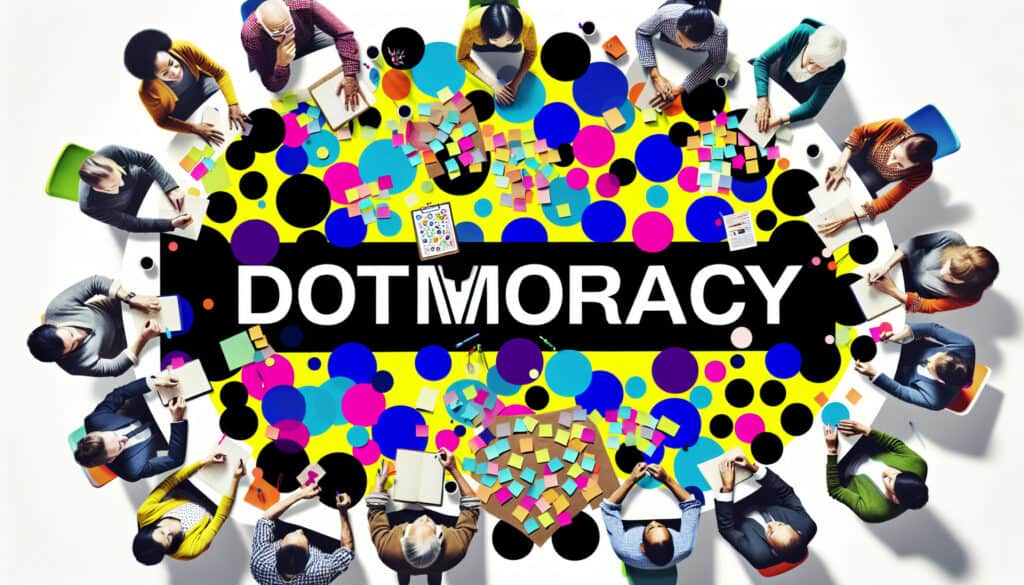Una simple facilitación método se utiliza para ayudar a un gran grupo de personas a priorizar una lista de opciones de forma democrática y visual.
- Metodologías: Ingeniería, Calidad
Dotmocracy

Dotmocracy
- Metodología ágil, Mejora continua, Pensamiento de diseño, Ideación, Innovación, Gestión de proyectos, Trabajo en equipo, Diseño centrado en el usuario
Objetivo:
Cómo se utiliza:
- Después de generar una lista de ideas y colgarla en la pared, cada participante recibe un pequeño número de pegatinas (puntos). A continuación, colocan sus puntos en las opciones que prefieren, lo que permite al grupo ver rápidamente qué ideas tienen más apoyo.
Ventajas
- Es una forma muy sencilla, rápida y transparente de medir el consenso del grupo; es muy democrática y fomenta la participación igualitaria; proporciona un resumen visual claro de las prioridades.
Contras
- Puede llevar al "pensamiento de grupo", en el que las personas se ven influidas por dónde han colocado sus puntos los demás; no permite debatir ni matizar por qué se prefiere una opción.
Categorías:
- Ideación, Resolución de problemas, Gestión de proyectos
Ideal para:
- Priorizar rápida y democráticamente una lista de ideas en grupo utilizando pegatinas o puntos.
La dotmocracia es especialmente beneficiosa en entornos en los que la toma de decisiones colaborativa es fundamental, como en los talleres de pensamiento de diseño, los proyectos de participación comunitaria y las sesiones corporativas de intercambio de ideas. Sectores como el desarrollo de productos, la planificación urbana y el diseño de programas educativos utilizan con frecuencia esta metodología, sobre todo en las fases conceptuales, en las que los distintos puntos de vista son esenciales para orientar un proyecto. En una sesión de Dotmocracy pueden participar diseñadores, ingenieros, partes interesadas en el proyecto y usuarios finales, lo que permite una rica muestra representativa de opiniones que puede mejorar el proceso de generación de ideas. Este método es adaptable a diversos contextos, desde las fases iniciales de generación de ideas hasta las evaluaciones finales de las soluciones propuestas, y proporciona un marco claro para la priorización colectiva. La representación visual de los puntos sobre las ideas crea una comprensión inmediata del consenso dentro del grupo, facilitando la identificación de los conceptos que más resuenan entre los participantes. Esta forma rápida de evaluación no sólo acelera la toma de decisiones, sino que también aumenta el compromiso, ya que todos tienen la misma oportunidad de opinar sobre las opciones presentadas. Resulta especialmente útil en situaciones en las que el tiempo es limitado y se necesitan ciclos de retroalimentación rápidos, lo que permite a los equipos girar en función de las preferencias colectivas sin necesidad de debates extensos o discusiones prolongadas. Con herramientas como las notas adhesivas o las plataformas digitales que simulan este proceso, las organizaciones pueden mantener la transparencia y la inclusión, garantizando al mismo tiempo que se escuchen todas las voces en las primeras fases del diseño y el desarrollo del producto.
Pasos clave de esta metodología
- Presente la lista de ideas generadas para que la vean todos los participantes.
- Distribuya un número limitado de pegatinas o puntos a cada participante.
- Permita que los participantes coloquen sus puntos sobre las ideas que prefieran.
- Identifique las ideas con mayor número de puntos como las más apoyadas.
- Discute las ideas más destacadas en función de la colocación de los puntos para seguir estudiándolas.
Consejos profesionales
- Anime a los participantes a agrupar ideas similares antes de la votación por puntos, lo que aumentará la claridad y reducirá la redundancia en las opciones presentadas.
- Limita el número de puntos por participante para evitar resultados sesgados de las voces dominantes; esto fomenta una aportación más equilibrada de todo el grupo.
- Tras la votación, facilite un breve debate para comprender el razonamiento que subyace a las selecciones, lo que puede revelar ideas más profundas sobre las prioridades del grupo.
Leer y comparar varias metodologías, recomendamos el
> Amplio repositorio de metodologías <
junto con otras más de 400 metodologías.
Sus comentarios sobre esta metodología o información adicional son bienvenidos en la dirección sección de comentarios ↓ , así como cualquier idea o enlace relacionado con la ingeniería.
Historical Context
1960
1980
1983
1990
1995
2000
2010
1950
1980
1980
1986
1994
1995
2000
(if date is unknown or not relevant, e.g. "fluid mechanics", a rounded estimation of its notable emergence is provided)














Publicaciones relacionadas
Cuestionarios sobre molestias musculoesqueléticas
Pruebas multivariantes (MVT)
Análisis de regresión múltiple
Sistemas de captura de movimiento
Método MoSCoW
Prueba de la mediana de Mood